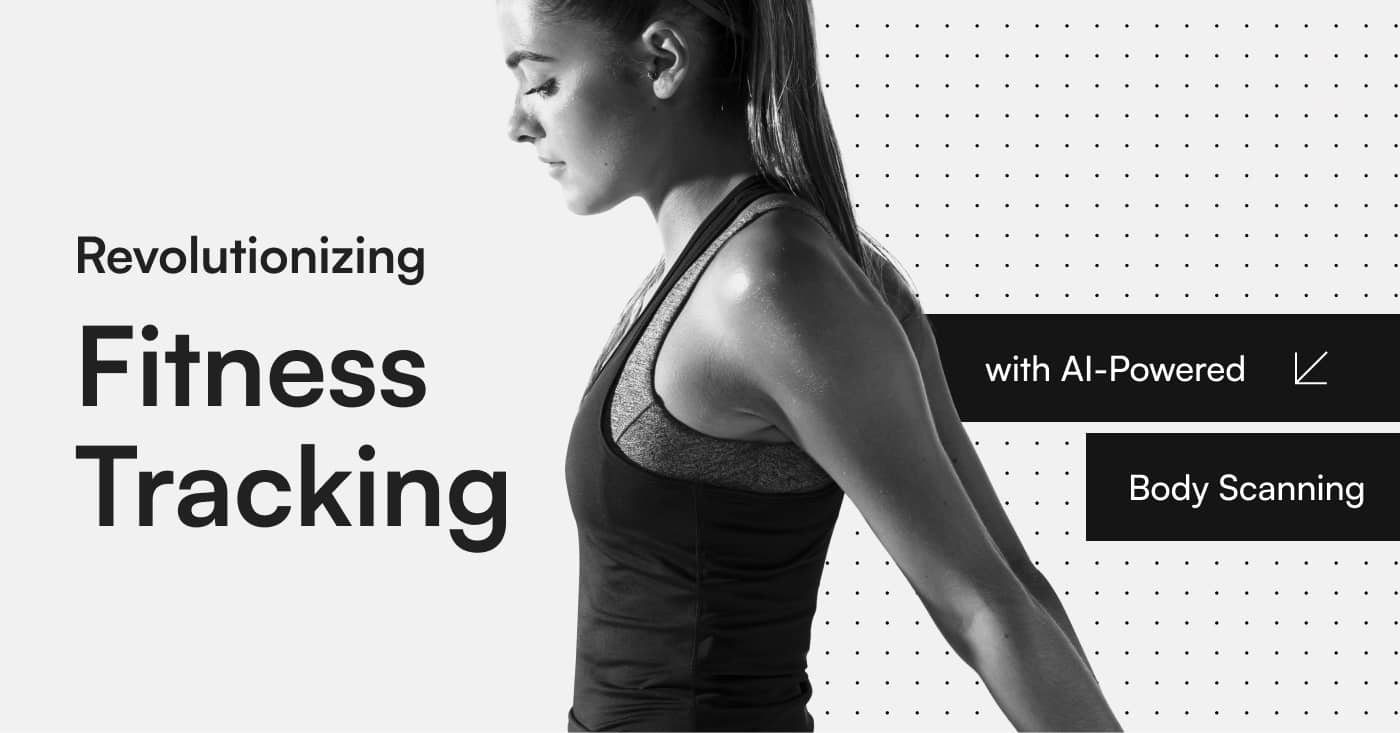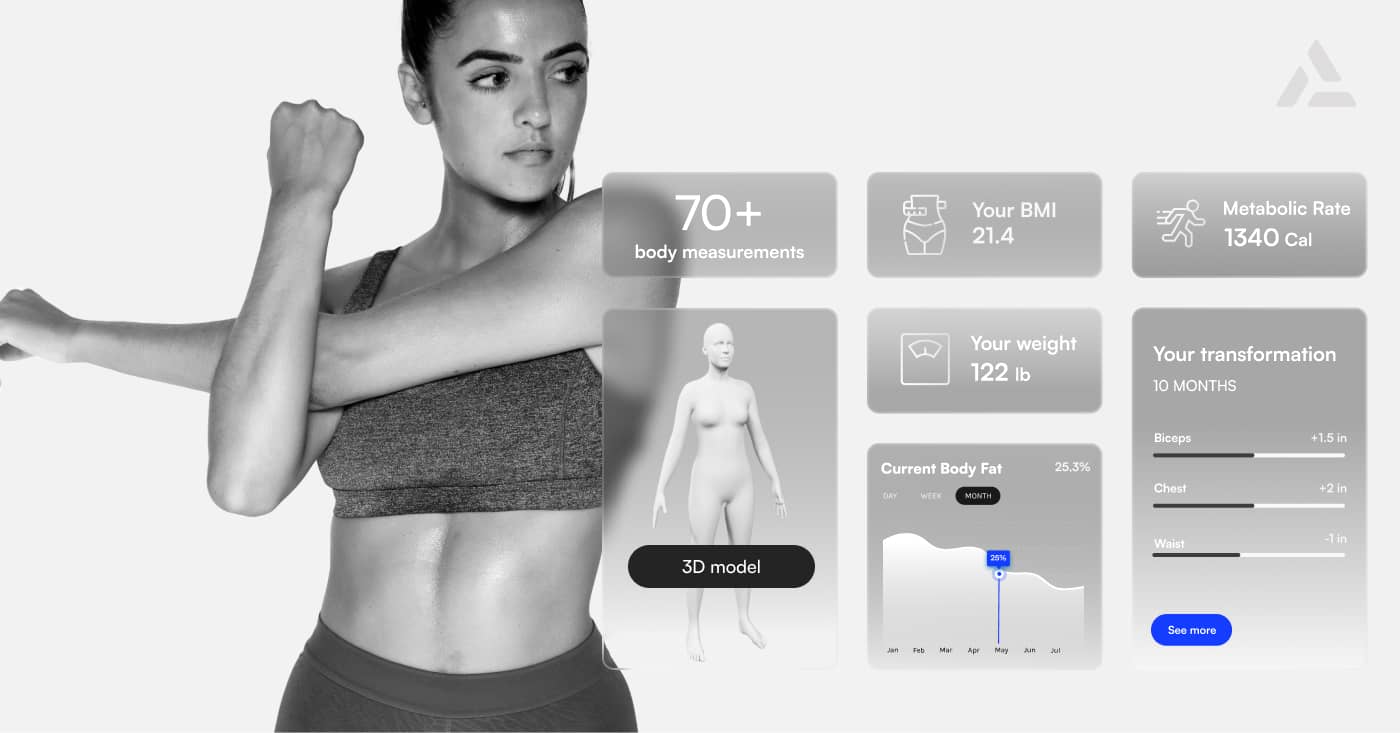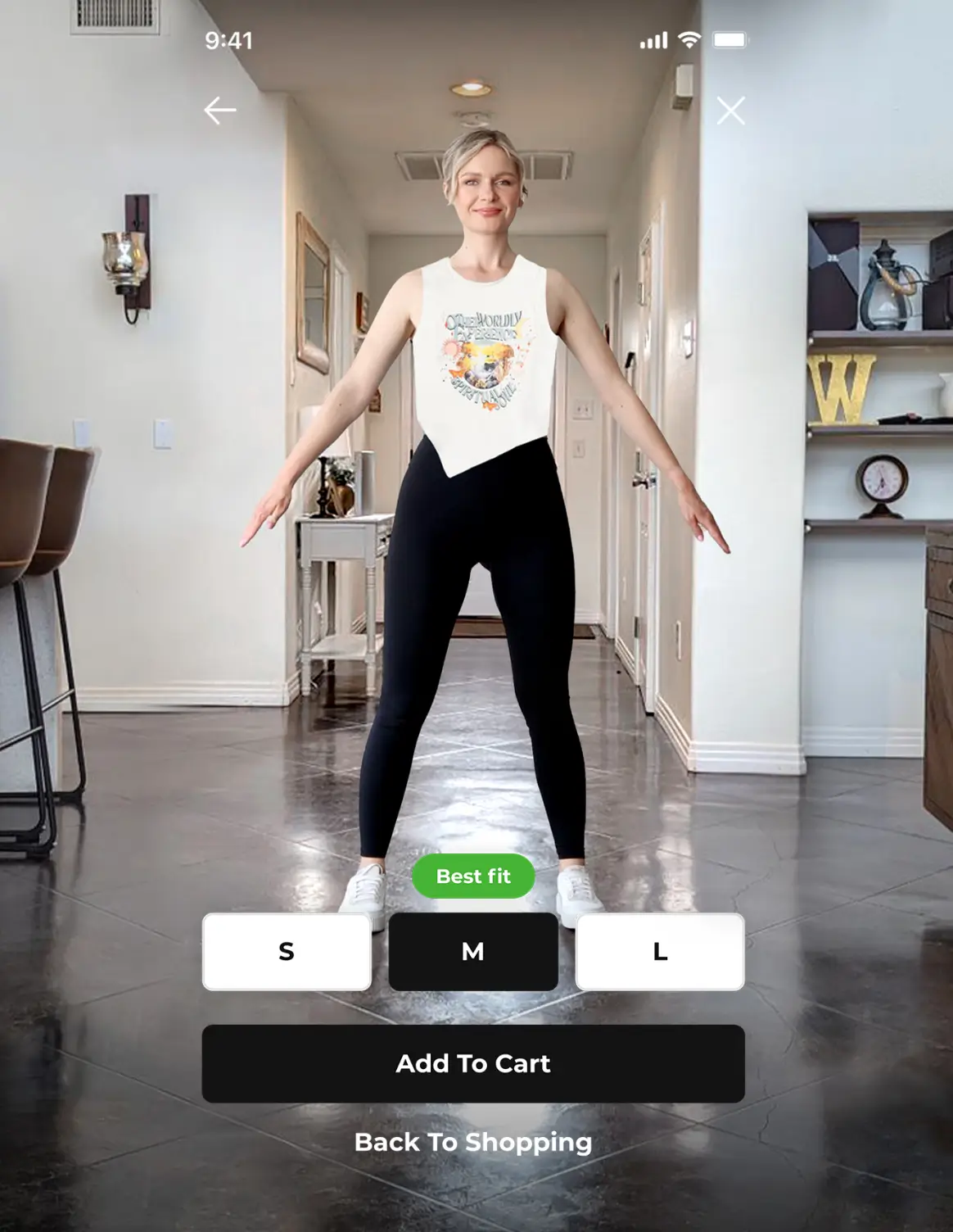Emerging as a key innovation in health and wellness, AI fitness applications deliver customized workout regimes tailored through advanced full-body scanning technology. With the global fitness app market growing over 10% annually, AI technology is poised to revolutionize the gyms of the future as well as remote personal training. Moreover, AI-powered body scanning solutions address the persistent challenge of customer churn in fitness apps. By merging AI body scanning’s precision with personalized feedback and monitoring, customer retention can be substantially enhanced.
Introduction: AI Body Tracking – A New Era in Fitness Monitoring
The typical image of a fitness enthusiast is a person holding a smartphone or wearable fitness tracker while sending “sweaty selfies” to friends doing the same program or routine.
Today, we can’t imagine how else we could understand our bodies and track our fitness and workout progress without relying on technology.
In this regard, AI body tracking is at the forefront, poised to transform the landscape of fitness monitoring.
Initially, it delivers unprecedented accuracy in tracking body composition. Using artificial intelligence to analyze and interpret physical movements and postures, this technology leverages machine learning algorithms and computer vision to provide valuable data regarding users’ physical condition and fitness progress.
But let’s explore the role of body measurements in fitness and how they’ve progressed over time.

The Evolution of Body Measurement Insights in Fitness
Early humans didn’t exercise for fitness; their daily activities required them to be fit to survive. This was available until around the 1970s, with the advent of jogging and Jazzercise, and the concept of fitness as a measure of health and well-being became a trend.
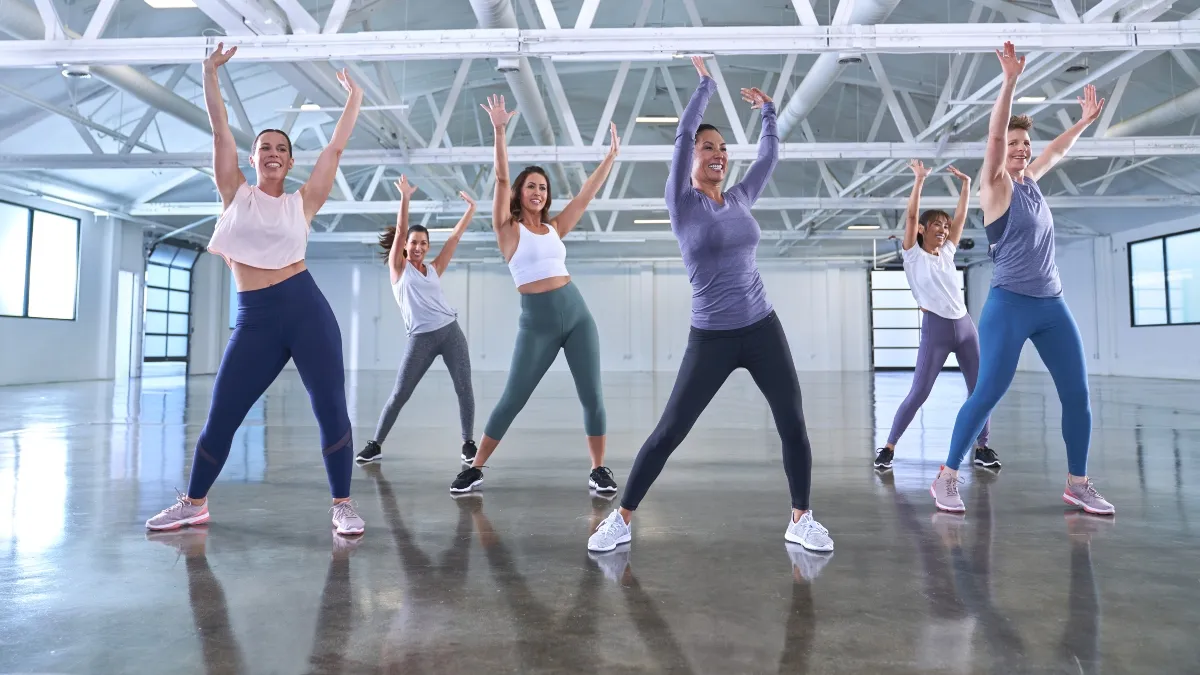
Besides how fast one could run or walk, fitness was also assessed through other performance-based measures, like how much one could carry or handle workout exercises.
Today, people use body measurements to assess body composition changes, track fitness progress, and set health goals. Fitness specialists use various screening tools, including height, waist circumference, hip-to-waist ratio, resting heart rate, and blood pressure – all meant to establish a baseline health profile. They also help individuals understand their body composition and monitor their progress toward fitness goals.
From Tape Measures to AI Body Scan Fitness Apps
For decades, fitness enthusiasts have relied on simple tools like tape measures and basic metrics to track body measurements. While these methods provided a general overview of changes in body composition, they often needed more precision and detail. Plus, the manual process was time-consuming and required the assistance of another person, making it less convenient for regular tracking.
Body Mass Index (BMI) is a common tool that has evolved over time and remains a widely used metric due to its simplicity and ease of calculation. It measures a person’s body fat based on their height and weight.
However, while BMI is a useful indicator of healthy body weight, it doesn’t directly measure body fat.
The latest frontier in body measurement technology is AI-powered body scan fitness apps. These innovative apps analyze body composition more accurately and efficiently.
An AI body scan app like FitXpress harnesses the power of just two photos taken with the user’s smartphone to produce over 80 measurements and a detailed 3D body model. Plus, it gives estimates for fat percentage and calculations for both BMI and BMR (Basal Metabolic Rate). This comprehensive approach captures a holistic view of the user’s body shape, weight fluctuations, and overall fitness levels.
AI body scanning is non-invasive, convenient, and provides a level of detail and accuracy previously only available in specialized clinics. Many apps built on this technology offer personalized recommendations and insights based on your specific goals and preferences.
Precision and Speed: AI Fitness Body Scan in Action
By leveraging AI, these fitness body scanners can provide a comprehensive and quick analysis of a person’s body, contributing to improved health and fitness outcomes.
AI fitness body scans are precise and fast as they rely on:
Advanced technology: AI fitness scanners use advanced technologies like multiparametric MRI and human pose estimation. The technology uses neural networks trained on a vast dataset comprising hundreds of thousands of user-generated photos alongside manually measured and scanned consumer data.
Efficiency: The scanning process is much faster than traditional methods. For example, while standing on a rotating platform for 30 seconds, an infrared sensor captures the body’s shape, composition, and measurements by taking hundreds of images. With FitXpress, users can complete a full-body scan using just two photos taken with their smartphone.
Precision: These scanners can perform real-time analysis of users’ exercise recordings and provide suggestions on improving exercise form and biomechanics.
Visualizing Fitness Progress with AI and 3D Models
One of the key benefits of using AI for weight tracking is the ability to self-monitor effectively. Studies have shown that individuals who consistently track their progress with digital tools tend to lose more weight than those who don’t. AI and 3D models can provide real-time feedback, allowing users to make immediate adjustments to their workout plans.
AI-powered body scanning technologies, like FitXpress, offer a seamless way to capture detailed body measurements using a smartphone camera. Algorithms use hundreds of key points to generate a 3D body model and accurately measure the body, allowing for a visual representation of physical changes over time.
This method offers a more engaging experience and provides precise data that can help personalize fitness plans to an individual’s unique body shape and composition.
Users can set personal goals and compare progress in a more interactive and personalized way. This can also serve as a powerful motivational tool, giving users a glimpse of potential future results.
Yet, the use of such technologies isn’t limited to individual users. Fitness centers and wellness brands can leverage insights into body composition to enhance customer engagement and retention. Plus, it helps personal trainers and health coaches monitor their clients’ progress.
The Role of Fitness Progress Photo Apps in Modern Training
It’s very common to look in the mirror and think you’ve made no progress, overlooking the strides you’ve made. By capturing visual evidence of your journey, progress photos provide an objective perspective, ensuring that even subtle changes are recognized and celebrated.
That said, fitness progress photo apps eliminate the subjectivity often associated with assessing your fitness progress. Plus, with solutions such as FitXpress, you’ll better understand your nuances concerning the correlation between weight loss and muscle growth, with the latter frequently mistaken for weight gain.
Seeing physical changes over time can be highly motivating and help users stay committed to their fitness goals.
The personalized experience AI-powered fitness apps provide can enhance user engagement and satisfaction. Additionally, the instant generation of body data ensures users have immediate insights, reinforcing accountability to their fitness goals.
Weight Gain Progression and Loss Tracking with AI
It’s already known that weight loss doesn’t work the same for everyone. However AI technology has already proved that it could positively impact weight loss. Based on a 2017 study,
the use of an AI health coach had a higher impact on weight loss compared to in-person lifestyle interventions. It also encouraged behavior and lifestyle changes that improve people’s health and well-being.
AI-powered weight tracking solutions provide highly accurate and precise measurements, ensuring users have reliable data to inform their progress.
First, they enable real-time monitoring of weight changes, allowing users to track their progress continuously throughout the day. Whether it’s fluctuations in weight due to hydration levels, dietary choices, or exercise habits, AI algorithms can provide instant feedback and insights.
Many AI fitness apps use your age, gender, activity levels, and desired weight loss to determine your optimal daily intake.
Another advantage of AI in weight management is its capacity for predictive analytics. AI can predict potential weight loss challenges, such as dietary lapses or emotional eating, enabling users to proactively prepare and counteract these obstacles.
Real-World Applications of AI Body Scanner Apps
AI body scanner apps have a wide range of real-world applications. Examples include:
- Health monitoring – allows for regular monitoring and early detection of potential health issues.
- Fitness tracking – provides precise body measurements, making it easier for individuals to track their fitness progress.
For instance, Bodygee is an AI-powered body scanning app that allows users to capture 3D body scans using their smartphone camera. The app generates accurate body measurements and provides personalized fitness recommendations based on the user’s body composition.
- Fashion and retail – used for virtual try-on experiences.
For instance, 3DLOOK’s Mobile Tailor provides accurate body measurements, which can help in customizing clothing sizes and improving the overall shopping experience.
- Medical diagnostics – help in the early detection of health issues, thereby aiding in preventive healthcare.
Neko Health stands out among AI-powered health apps. Neko’s trained operators carry out a full body scan, collecting millions of data points in minutes. It’s designed to help doctors detect diseases in time by easily and cost-effectively collecting, interpreting, and visualizing millions of data points.
Enhancing Gym Experiences with Body 3D Model Weight Analysis
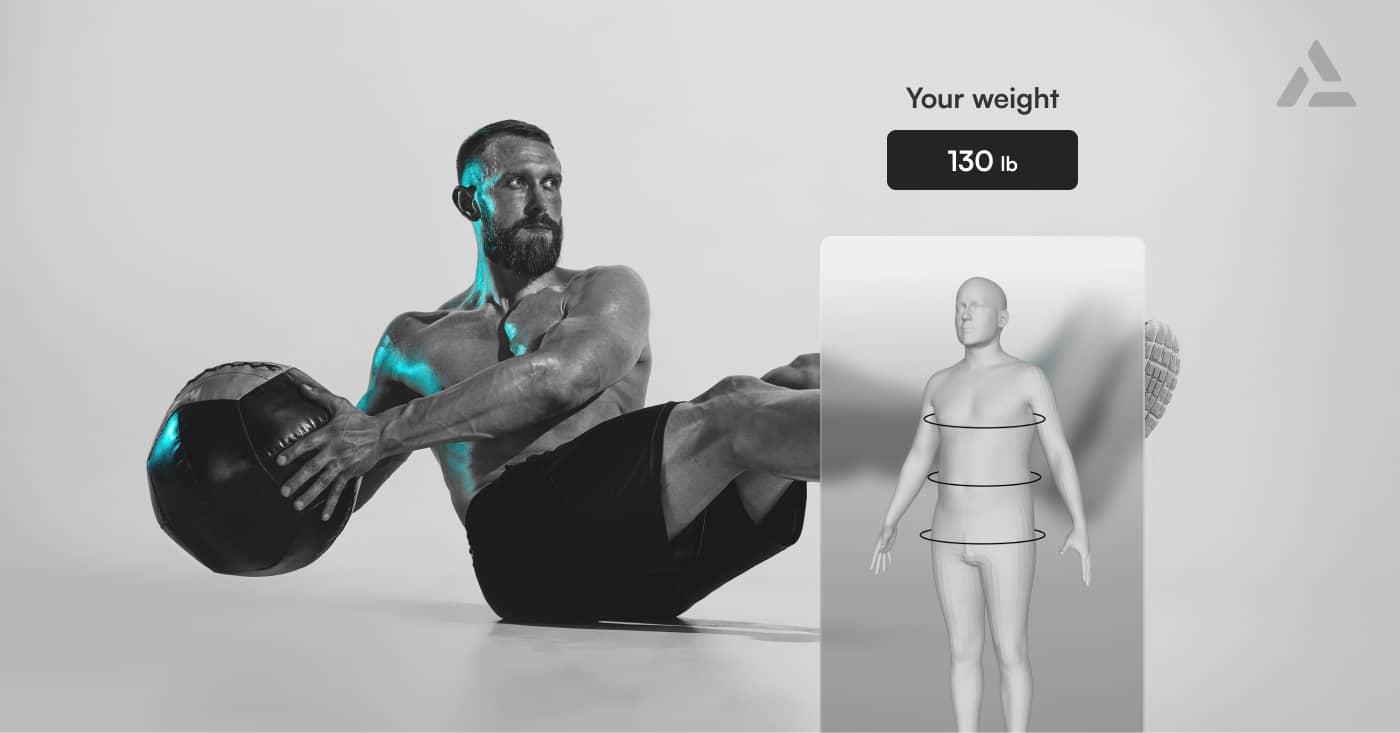
3D body weight analysis models offer a more objective and comprehensive way to track progress over time. It includes a three-dimensional model and ultra-specific information about a person’s body shape analysis, body fat analysis, and a fat loss calculator.
3D body scanning also helps users understand their body composition in detail. It shows where they distribute their weight, which can be particularly helpful for targeting specific areas during workouts.
Gym-goers can set more realistic and targeted fitness goals with a clearer understanding of their body composition. Individuals can set measurable goals based on their 3D body weight analysis results to decrease body fat in specific areas or increase muscle mass.
AI Body Tracking Offers the Next Level of Personal Training
With AI-powered body or motion tracking apps becoming widely available and accessible, their primary benefit is ease of use and convenience.
Statistics show that 84% of gym-goers use some form of AI technology during their workouts.
People no longer have to schedule and spend time commuting to be physically present in a gym or fitness class. They can do their workouts at home or anywhere they wish. This means personalized fitness guidance and expert-level training advice, available a few clicks away.
This personalized guidance and training includes a customized workout plan after considering factors like exercise history, current fitness levels, and personal goals. The AI body tracking app can tailor workout routines that are both challenging and achievable, ensuring continuous progress and adaptation.
Driving User Engagement and Retention with FitXpress
The interactive nature of 3D body scanning can easily increase user engagement. Some apps allow users to experiment with different visual features, like muscle definition or fat, providing an engaging way to explore their fitness journey.
FitXpress, for instance, can show fitness customers in real-time how the changes in their metabolic rate affect their weight loss. Customers are also encouraged to track and compare their progress, keeping them motivated and engaged. Visual proof of progress increases client satisfaction and retention. Clients who see their improvements are more likely to continue with their training program.
From feedback to real-time coaching and predictive analytics, these apps drive user engagement and retention, ultimately improving fitness outcomes and long-term user satisfaction.
Discover how AI-powered body data is revolutionizing health, fitness, and weight management, setting a new standard for personalization and progress tracking.
Leveraging AI Body Scans to Boost Fitness App Usage
Visual progress tracking, personalized fitness plans, and accurate health metrics are key ingredients that keep users engaged and motivated, ensuring they don’t abandon their fitness goals.
AI’s Impact on Health and Fitness App User Retention
The average retention rate for fitness apps is about 53% after the first month.
Despite a promising star, fitness apps face a steep challenge: keeping users engaged and motivated. Astonishingly, 71% of users abandon their apps in 3 months. Some reasons for calling it quits include lack of personalization and difficulty understanding if and how they’re making progress.
That’s something that advanced AI fitness apps change for the better.
AI body scans allow users to track their fitness progress visually. This can be particularly motivating, as users can see their body shape and weight changes, making it less likely for them to abandon their health objectives.
AI body scans also help develop a complete picture of the user’s body shape, weight changes, and fitness levels.
The high level of customization and foresight sets AI-powered fitness apps apart from traditional ones, making them a valuable tool for users looking to enhance their fitness journey.
Conclusion: Embrace the Future with FitXpress’s AI-Powered Fitness Tracking
The evolution of body measurements in fitness has been marked by innovation and technological advancement.
AI and 3D modeling are providing exciting new ways to visualize fitness progress. These technologies offer a level of detail and personalization that traditional methods cannot match, making the fitness journey more engaging, measurable, and, ultimately, more successful.
FitXpress provides users with a comprehensive view of their health and an in-depth look at their health progress that can spur motivation and improve engagement and retention.
Whether you are an individual, personal coach, fitness center owner, or huge tech-forward fitness organization, you can leverage AI body tracking apps like FitXpress that stand as a game-changer in the fitness industry.
As the integration of advanced AI technology with fitness deepens, the future of body measurements and body composition data in the fitness and weight loss journey promises revolutionary advancement, enhancing ease, accuracy, and personalization in tracking progress like never before.
